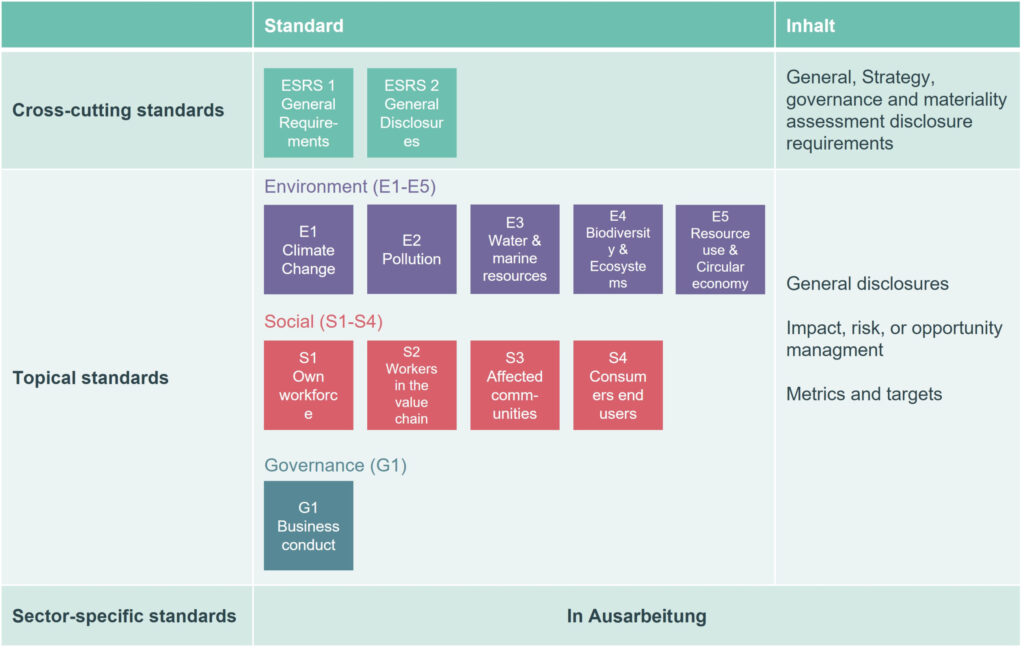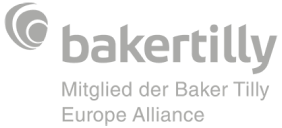9. March 2023
Reading Time: 6
Min.
news
European Sustainability Reporting Standard 1: General requirements
The European Sustainability Reporting Standards (ESRS) were developed by the European Financial Reporting Advisory Group (EFRAG) and are to be applied in accordance with the CSRD (Corporate Sustainability Reporting Directive). This is intended to ensure that companies disclose their impact on people and the environment as well as the risks arising from climate change in a transparent manner. This article is based on the delegated regulation of the ESRS which was published in the Official Journal of the EU on 22nd December 2023. Here you can find a general overview of the ESRS.
The ESRS are divided into two categories: Cross-cutting Standards and topical Standards (Environmental, Social and Governance). This article takes a closer look at the ESRS 1 General Requirements standard, which can be categorised as a cross-cutting standard. The aim of ESRS 1 is to set out basic requirements for non-financial reporting in accordance with the CSRD.
The content of ESRS 1 is structured as follows:
- Categories of ESRS Standards, reporting areas and drafting conventions
- Qualitative characteristics of information
- Double materiality as the basis for sustainability disclosures
- Due diligence
- Value chain
- Time horizons
- Preparation and presentation of sustainability information
- Structure of sustainability statement
- Linkages with other parts of corporate reporting and connected information
- Transitional provisions
Categories of ESRS Standards, reporting areas and drafting conventions
In general, when reporting under ESRS, all material information about a company’s impacts, risks and opportunities related to environmental, social and governance issues should be disclosed as part of the management report. The disclosure requirements relate to governance, strategy, impact, risk and opportunity management, and metrics and targets. ESRS can be divided into topical and entity-specific standards. Topical ESRS are subdivided into sector-agnostic and sector-specific ESRS. If a material topic is not or insufficiently covered by the ESRS, it is conceptually intended that companies develop their own entity-specific disclosure standards.
Qualitative characteristics of information
When preparing a sustainability statement, the reporting quality is to be ensured by the principles of relevance and credible presentation of information, as well as comparability, verifiability and comprehensibility.
Double materiality as the basis for sustainability disclosures
Reporting according to ESRS is characterized by the principle of double materiality and companies should disclose sustainability information based on this. The company’s stakeholders are to be included in the materiality analysis process. The principle of double materiality considers impact materiality on the one hand and financial materiality on the other, which are interlinked. A sustainability aspect shows material impact if it relates to significant actual or potential, positive or negative effects of the company on people or the environment in the short, medium or long term. Financial materiality is fulfilled if a sustainability aspect has or can have a material financial impact on the results of operations in the short, medium or long term. Companies must first conduct a materiality analysis to identify the significant impacts, opportunities and risks. A list of sustainability aspects contained in the annex to the ESRS 1 standard is to be used as guidance. If the materiality analysis shows that a sustainability aspect is material, the company must report on it. If companies classify a sustainability aspect as immaterial after conducting the materiality analysis, a justification must be provided. Regardless of the result of the materiality analysis, information that must be disclosed is presented in ESRS 1.
Due diligence
The results of a sustainability due diligence process are intended to provide information for assessing significant impacts, risks and opportunities. The due diligence process is intended to identify, prevent and mitigate potential and actual negative impacts of the company on the environment and people. The elements of sustainability due diligence are explored in more detail in ESRS 2: General disclosures. In this the embedding of sustainability due diligence in corporate governance, strategy and business model, as well as the importance of stakeholder engagement are described in more detail.
Value chain
The company responsible for the annual financial statements is also responsible for reporting the sustainability statements. The reporting company must also include the material impacts, risks and opportunities of the company’s upstream and downstream value chain in the reporting. If information on the value chain cannot be collected or can only be collected inadequately, the company must estimate the information to be reported using appropriate information.
Time horizons
The reporting period for sustainability reporting must correspond to that of financial reporting. Short-term, medium-term and long-term time horizons are to be considered in the reporting.
Preparation and presentation of sustainability information
Companies must disclose comparative information for one year for all key figures stated in the current period. This also applies to descriptive and explanatory sustainability disclosures. If the key figures of the years deviate from each other, the difference as well as the reason for the deviation must be explained. In the case of estimates and assumptions, e.g. in the area of the value chain, the company must describe and explain these in detail.
Structure of sustainability statement
The reader should be able to distinguish between the information to be disclosed in accordance with ESRS and other disclosures in the management report. In addition, companies must choose a structure that makes the information easy to grasp and read by both humans and machines. In addition to ESRS, companies may also refer to other standards resulting from local legislation or international standards.
Linkages with other parts of corporate reporting and connected information
The disclosures made are intended to enable users to evaluate the relationships between the various items of information about impacts, risks and opportunities and in other areas of the entity’s reporting. The company must therefore present all disclosures in a single section of the management report, except where presentation by reference is permitted. Disclosures may be made by reference to another section of the management report or other documents, such as the annual financial statements, if the documents are published at the same time as the management report, have at least the same level of assurance as the sustainability disclosures, and meet the technical digitization requirements. The disclosures made by reference must be clearly identifiable as statements that comply with the disclosure requirement under CSRD.
Transitional provisions
There are transitional provisions for the first three sustainability statements regarding company-specific and value chain-related information. Due to the further development of the standards, it is expected that the need for company-specific disclosures will decrease. If certain information on the value chain is not available to the company, the company is allowed to explain the reasons for the lack of information in the first three years, as well as plans on how the information will be obtained. If SMEs are involved in the value chain of a reporting company, there is also a simplification for information to be reported within the first three reports. Companies are also allowed to omit the disclosure of comparative figures in the first report.










